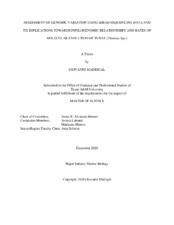| dc.description.abstract | Tunas are an ecologically and economically important group of fishes, and have received attention by numerous researchers for decades. Despite decades of research, their phylogenomic relationships and evolutionary history remains ambiguous and controversial. Increasing fishing pressures and climate change have warranted a better understanding of these fishes, as understanding their past is imperative towards understanding their future. This study focused on: 1) providing a bioinformatic framework for dealing with missing sites using double digest restriction-site associated sequencing (ddRAD-Seq) data in phylogenomics using tunas as an example, 2) the construction of a phylogeny using diagnostically useful single nucleotide polymorphisms (SNPs) for Thunnus spp., 3) the revaluation of Bigeye Tuna’s (T. obesus) phylogenomic position in relation to temperate and tropical tunas, 4) offering an average rate of molecular evolution for members of Thunnus, and 5) the estimation of a timeline of speciation events within Thunnus. Applying both concatenation and species tree methods using untrimmed and trimmed data provided the support towards concatenation and the inclusion of missing sites when using ddRAD-Seq to construct a phylogenetic tree. Despite the potential pitfalls with ddRAD-Seq, this study was able to capture informative phylogenetic markers that successfully separate individual species, placing Bigeye Tuna within the tropical Yellowfin Group. Constructing a timetree for Thunnus resulted in congruent results, with the timetree indicating the lineages for the temperate and tropical tunas are relatively old (> 50 million years). A relatively high rate of molecular evolution is associated with the Bigeye Tuna clade when compared to the other tunas in this study, which are estimated to have a relatively slow rate of molecular evolution when compared to several other taxonomic groups (e.g., mammals). Historic ocean cooling may have driven Bigeye Tuna to diverge from the Yellowfin Tuna in search of resources in cooler and deeper waters, with annotated sequences in line with morphological differences between temperate and tropical tunas. Overall, this study provides evidence towards Bigeye Tuna’s placement in the Neothunnus, and suggests this species may have undergone a relatively rapid speciation event leading to convergent evolution in Thunnus. | en |


